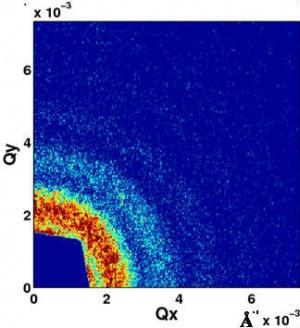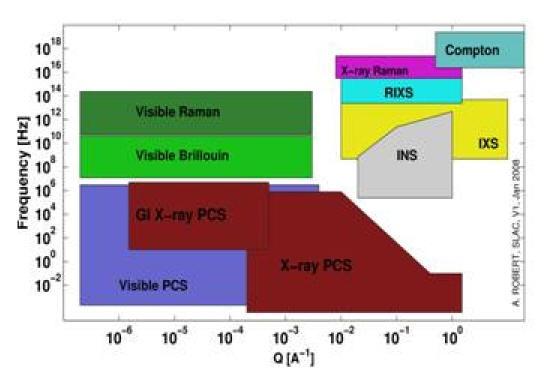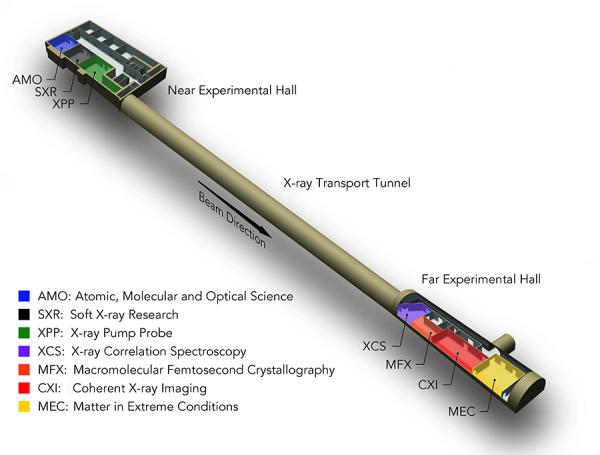XCS Overview
XCS Full Name
X-ray Correlation Spectroscopy Instrument
Short Description
The unprecedented brilliance and narrow pulse duration of the Linac Coherence Light Source provides a unique opportunity to observe dynamical changes of large groups of atoms in condensed matter systems over a wide range of time scales using Coherent X-ray Scattering (CXS) in general and X-ray Photon Correlation Spectroscopy (XPCS) in particular. The X-ray Correlation Spectroscopy (XCS) instrument at the LCLS allows the study of equilibrium- and non-equilibrium dynamics in disordered or modulated materials.
X-ray Photon Correlation Spectroscopy Technique
Coherent X-rays are particularly well suited for investigating disordered system dynamics down to nanometer and atomic length scales, using X-ray Photon Correlation Spectroscopy [1]. When coherent light is scattered from a disordered system, the scattering pattern present a peculiar grainy appearance also known as speckles, as illustrated in Figure 1 [2].

These speckles originate from the exact position of all scatterers within the system under investigation. XPCS characterizes the temporal fluctuations in speckle patterns, produced when coherent light is scattered by a disordered system. From these fluctuations, insight in the dynamic behavior of the system can be revealed.
XPCS, as currently performed on 3rd generation synchrotron light sources (Advanced Photon Source, European Synchrotron Radiation Facility. PETRA III) is complementary to Dynamic Light Scattering (DLS) or Photon Correlation Spectroscopy (PCS) with visible coherent light, techniques that probe slow dynamics (<106 Hz) but can only access the long wavelength regime (Q < 4 ·10-3 Å-1). Neutron-based techniques (inelastic, quasi-elastic neutron scattering, neutron spin-echo) and Inelastic X-ray Scattering (IXS) can access the same Q range as XPCS, but these techniques probe the dynamic properties of matter at high frequencies (from typically 108 Hz to about 1017 Hz), as illustrated in Figure 2.

The XPCS areas (in transmission/diffraction and grazing incidence (GI) geometry) are defined from existing measurements performed at the existing 3rd generation synchrotron light sources instruments. The peak coherent flux of the LCLS radiation will be 9 orders of magnitude larger than 3rd generation synchrotron light sources. This will allow for the first time the studies of dynamics up to about 1013 Hz at large Q’s using the fine pulse structure of the LCLS beam. The unique capabilities of the XCS instrument at LCLS enables to address a wide variety of scientific questions, such as coherent optical properties of hard X-rays, phase transition dynamics, dynamics of glassy materials, surface XPCS, non- equilibrium dynamics, local ordering in disordered materials.
Example of Scientific Programs
Phase Transition Dynamics
Atomic-scale fluctuations occur at equilibrium near many phase-transitions. These fluctuations are the basis for the new phases that form when the phase transition point is crossed by changing relevant physical parameters, such as temperature, electric or magnetic field, pH, etc …. XPCS is an ideal tool for observing the equilibrium dynamics of these fluctuations, and understanding the mechanisms that control microstructure formation in materials. For example transitions in magnetic, ferroelectric and ferroelastic materials exhibit time scales spanning from sub-picoseconds to many seconds in the vicinity to the transition point.
Dynamics and Local Ordering of Glassy Materials
Many liquids, when rapidly cooled below their freezing point, form meta-stable glasses or amorphous phases. This applies for a wide variety of materials including metallic alloys, oxides such as silica, polymeric materials, and many others (e.g. colloidal dispersions for which the volume fraction is the analogous of the inverse temperature driving the phase transition). In general, glassy materials are among the least understood at a fundamental level. Conventional equilibrium statistical mechanics does not predict the existence of the amorphous state, whereas it can explain most other states of matter, even quite exotic ones like superconductivity and superfluidity. Understanding the dynamics and local ordering in glassy materials is thus an important topic of fundamental research.
Surface and Interfaces Dynamics
Surface XPCS experiments at 3rd generation storage ring sources have been performed successfully in the past, and surface dynamics have been investigated in a variety of systems, such as membranes, polymer films, and liquids. Surface XPCS in combination with the X-ray standing wave technique also allows the study of fluctuations of buried interfaces. However, surface dynamics at the nanometer length scale is not accessible today due to insufficient coherent photon flux. The XCS instrument at LCLS will provide exciting new possibilities in this science area.
Non-equilibrium Dynamics
When a disordered homogeneous material is rapidly brought to a new set of conditions, corresponding to the coexistence of equilibrium phases, a spatial pattern of domains of each phase develops. For example, such a change of conditions can be accomplished by a rapid quench from high to low temperature, below the miscibility gap. This results in the creation of a microstructure of interconnecting domains. These domains grow in order to minimize the areas of the domain walls that separate the phases. Out-of-equilibrium behavior has been observed in soft condensed matter glassy systems as well (i.e. attractive and repulsive colloidal glasses), where the dynamics are slowed down as a function of time and are described as aging. The XCS instrument at LCLS is ideal for studying these non-equilibrium systems where the dynamic behavior needs to be probed on all length scales simultaneously.
Coherence Properties of Hard X-rays
Coherence is one of the most prominent features of the novel radiation produced by the LCLS. A comprehensive understanding of the X-ray laser coherence properties is not only of fundamental interest but a necessity for properly interpreting coherence-based experiments such as Coherent X-ray scattering in general and XPCS in particular. The characterization of the coherence properties of the source in terms of correlation functions and photon statistics was successfully used for characterizing 3rd generation sources XPCS dedicated instruments. The study of first and higher order correlation functions will allow not only determine the spatial and temporal coherence parameters of the source (i.e. the longitudinal and transverse coherence lengths as well as the coherent flux) but it will also provide insight into the mode structure, photon statistics (bunching/anti-bunching) and possible non-Gaussian properties of the source.
References
- G. Grübel, A. Madsen, A. Robert, X-Ray Photon Correlation Spectroscopy (XPCS), Soft Matter Characterization, edited by R. Borsali & R. Pecora, pp. 953-995. Heidelberg : Springer.
- A. Robert, Measurement of self-diffusion constant with twodimensional X-ray photon correlation spectroscopy, J. Appl. Cryst. 40, (2007), pp. s34-s37
XCS CONTACTs
Matthieu Chollet
XCS Instrument Lead
(650) 926-2458
mchollet@slac.stanford.edu
Cynthia Melendrez
Area Manager
(650) 926 2377
cymel123@slac.stanford.edu
Roberto Alonso-Mori
Lead Scientist
(650) 926-4179
robertoa@slac.stanford.edu
Diling Zhu
Senior Scientist
(650) 926-2913
dlzhu@slac.stanford.edu
Tim van Driel
Staff Scientist
(650) 926 3241
timbvd@slac.stanford.edu
Takahiro Sato
Staff Scientist
(650) 926-3749
takahiro@slac.stanford.edu
Sanghoon Song
Staff Scientist
(650) 926-2255
sanghoon@slac.stanford.edu
Gourab Chatterjee
Laser Scientist
(650) 926-5559
gourab@slac.stanford.edu
XCS Control Room
(650) 926-1704
XCS Hutch
(650) 926-7980



